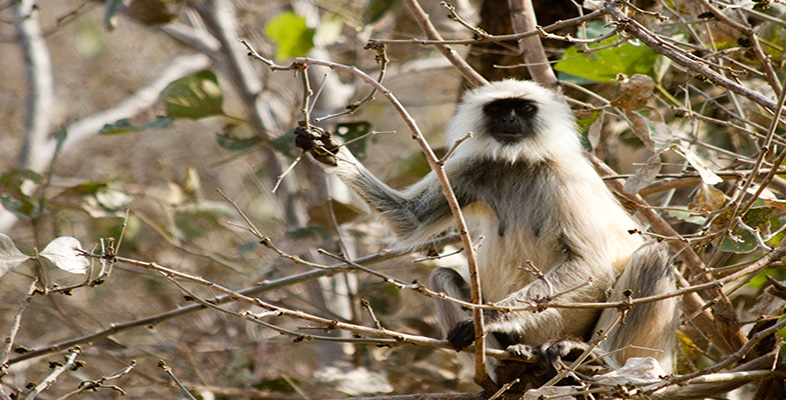3.3 Seeing red
Activity 3
Watch the TV programme from 20.37-24.06 and reread LoM pp. 247-248 and 255. Write a paragraph of about 120 words explaining why the inability to detect the colour red would disadvantage anthropoid primates. Try also to include any relevant information that you may have gained from studying other units in this series.
Answer
Although primates are omnivorous, leaves and fruit are important foods for many species. But many plants have evolved defence mechanisms to avoid predation. Most fruit is unpalatable and indigestible until the seeds inside are ready for dispersal. Similarly, newly emerging leaves may have high levels of poisons that can make primates unwell. As such leaves mature, the levels of poisons decrease but their relative toughness increases, making old leaves indigestible. Primates, therefore, need to distinguish ripe from unripe fruit and young leaves from old leaves. Recently emerged leaves on some tropical vegetation are red, becoming greener as they mature, and many ripe fruits are red or yellow, whereas unripe fruit are usually green. Primates that are unable to detect red would not be able to use these colour differences to select palatable foods.
Consequently, the gene mutation of an early catarrhine ancestor that led to the production of a third photopigment, which responds to red light, has been retained in Old World monkeys, apes and humans, presumably because the red-sensitive pigment confers a significant advantage.
Question 5
What term do you think biologists use to describe the visual system in Old World monkeys, apes and humans?
Answer
Trichromatic, because it involves three light-detecting pigments.
Trichromatic vision evolved convergently in only two genera of New World monkeys: howler monkeys and spider monkeys. As discussed in LoM pp. 248 and 255, any ancestral monkeys that were able to detect ripe fruit and red nutritious leaves more accurately had a competitive edge over other individuals.
Question 6
If this theory is correct, why is it surprising that trichromatic vision is rare in New World monkeys?
Answer
Because they also need to be able to detect ripe fruit and young leaves.
Recent research has perhaps solved this riddle. Researchers followed four anthropoid species feeding in the wild in Uganda. After the animals had left a feeding tree, the researchers compared the colours of leaves and fruit that had been dropped or nibbled on, with untouched leaves and fruit on the tree. Using meters that enabled them to mimic primate dichromatic and trichromatic vision, they found that dichromatic vision is sufficient to distinguish ripe fruit from unripe fruit, but not young leaves from old leaves, suggesting that detection of red leaves rather than ripe fruit may have been the main driving force behind the evolution of trichromatic vision. The selective pressure to detect red leaves may have been less in the New World because only 18-36% of young leaves flush red in New World vegetation, compared with 50-62% in Old World vegetation.
In diurnal mammals, cones and rods are scattered throughout the retina, with the concentration of cones increasing towards the middle. At the point where most incoming light is focused, there is a cone-rich area, the area centralis, which has a pit at its centre, the fovea (or yellow spot), that contains virtually no rods. These structures improve the visual image, making the detection of both predators and food items easier.
Food identification and detection of predators are not the only way in which primates use colour.
Question 7
From your studies to date, identify any additional ways in which anthropoid primates use colour.
Answer
Recognition of other individuals of the same species and selecting mates. You may recall the montage in the TV programme (25.36-25.46) showing the variety of markings amongst the guenons, or the badges of marmosets and tamarins mentioned in LoM p. 260. DA discusses mate selection several times in Chapter 9, reflecting the importance of colour in the ability of a male to attract females. For example, female uakaris prefer the males that have the reddest faces [p. 248] and female mandrills prefer males showing the brightest colours [p. 280]. Recent research has shown that female vervets prefer males possessing the brightest blue scrotums. Female of many species, such as baboons, signal their receptivity to mate by developing red sexual swellings [p. 275].
